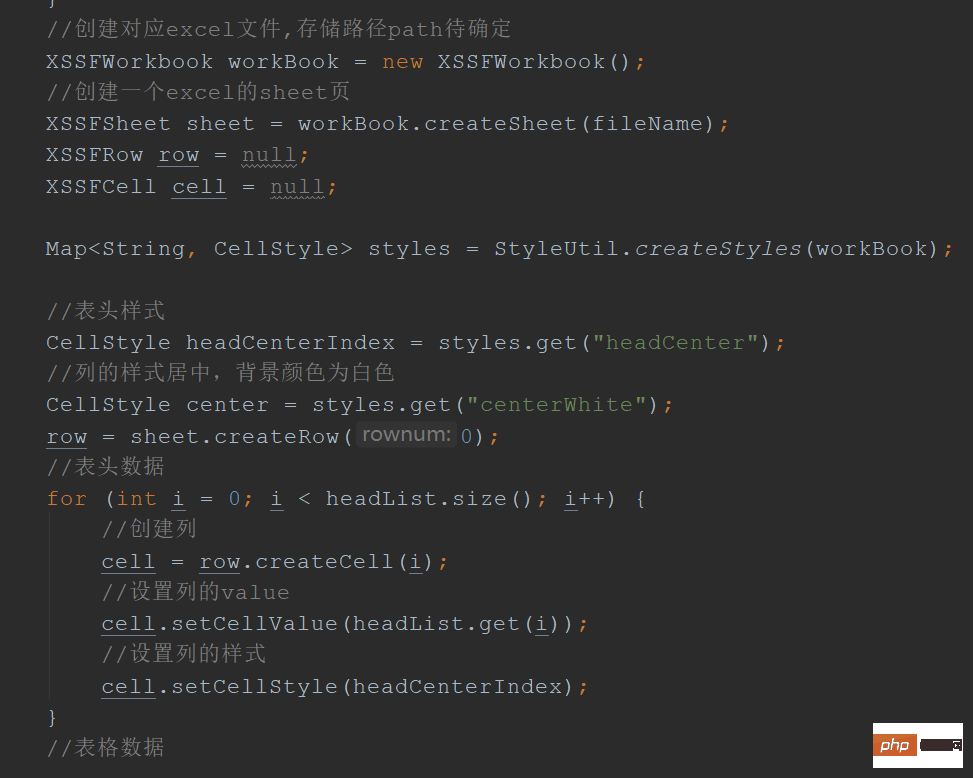How to export excel files using the export method in java
1.export function
//导出文件接口
public String export(){
return this.myExport(exportList);
}2.Export column name
private String myExport(List<BusinessDept> list){
com.bronzesoft.power.tools.json.JSONObject info = new com.bronzesoft.power.tools.json.JSONObject();
try{
List<String> headList = new ArrayList<String>(Arrays.asList("年", "月", "部门","部门负责人","经营值","收入", "支出","填报工时","标准工时","经营参数"));
Commonutil.export(list,headList,"部门经营总览导出");
info = Commonutil.setInfo(info,"部门经营总览导出");
}catch (Exception e){
LogUtil.error(this.getClass().getName()+".exportExcel()", e);
}
return info.toString();
}3.export implementation method
First, understand the organizational form of an Excel file. The Excel file corresponds to a workbook (XSSFWorkbook). A workbook can be composed of multiple sheets (XSSFSheet), a sheet is composed of multiple rows (XSSFRow), and a row is composed of multiple cells (XSSFCell).

public static <T> boolean export(List<T> list,List<String> headList,String fileName){
return myExport(list,headList,fileName,com.bronzesoft.rdm.platform.util.Constants.PATH + com.bronzesoft.power.platform.Constants.TEMPFOLDER_DIR );
}
//将list导出为excel,文件名为fileName
public static <T> boolean myExport(List<T> list,List<String> headList,String fileName,String path){
try{
if(!checkListAndHead(list,headList)){
LogUtil.info( "head的长度有问题,导出的文件不正确" );
}
File file = new File(path + File.separator + fileName + ".xlsx");
if(!file.exists()) {
file.createNewFile();
}
//创建对应excel文件,存储路径path待确定
XSSFWorkbook workBook = new XSSFWorkbook();
//创建一个excel的sheet页
XSSFSheet sheet = workBook.createSheet(fileName);
XSSFRow row = null;
XSSFCell cell = null;
Map<String, CellStyle> styles = StyleUtil.createStyles(workBook);
//表头样式
CellStyle headCenterIndex = styles.get("headCenter");
//列的样式居中,背景颜色为白色
CellStyle center = styles.get("centerWhite");
row = sheet.createRow(0);
//表头数据
for (int i = 0; i < headList.size(); i++) {
//创建列
cell = row.createCell(i);
//设置列的value
cell.setCellValue(headList.get(i));
//设置列的样式
cell.setCellStyle(headCenterIndex);
}
//表格数据
//写入表格数据
String codeName = "";
int rownum = 1;
T obj = null;
for(int i = 0; i < list.size(); i++){
obj = list.get(i);
if(null != obj){
Field[] fields = obj.getClass().getDeclaredFields();
row = sheet.createRow(rownum);
for(int j = 0; j< fields.length; j++){
fields[j].setAccessible(true);
codeName = String.valueOf(fields[j].get(obj));
//创建第j列
cell = row.createCell(j);
cell.setCellValue(Commonutil.getStringVal(codeName));
cell.setCellStyle(center);
}
}
rownum++;
}
// //i代表列,设置列的宽度
// for (int i = 0; i < headList.size(); i++) {
// if(i == 0){
// sheet.setColumnWidth(i, 2000);
// }else if(i == 1 || i == 3){
// sheet.setColumnWidth(i, 6000);
// }else{
// sheet.setColumnWidth(i, 4000);
// }
// }
//将文件写到临时目录
FileOutputStream out = new FileOutputStream(file);
workBook.write(out);
}catch (Exception e){
LogUtil.error(fileName + "export失败" );
}
return true;
}
//检查head的size是否符合规范
public static <T> boolean checkListAndHead(List<T> list,List<String> headList){
if(list.size()>0){
T t = list.get(0);
if(getColumnCount(t) != headList.size()){
LogUtil.info( "head的长度有问题" );
return false;
}
}
return true;
}
//获取一个对象成员变量的个数
public static <T> int getColumnCount(T t){
Field[] fields = t.getClass().getDeclaredFields();
int count = fields.length;
return count;
}4. Front-end docking
public static JSONObject setInfo(JSONObject info,String fileName) throws Exception {
Storage s = Commonutil.getDefaultStorage();
info.put("port", String.valueOf(s.getPort()));
info.put("dirAddress", Base64Util.encode(com.bronzesoft.rdm.platform.util.Constants.PATH));
info.put("address", Base64Util.encode(com.bronzesoft.power.platform.Constants.TEMPFOLDER_DIR + File.separator + fileName + ".xlsx"));
info.put("name", Base64Util.encode(fileName));
info.put("extendName", "xlsx");
return info;
}5. Front-end code
function doExport(){
synAjax.tabCall("com.bronzesoft.rdm.SeDeptTotalTab", "export", null, function(data){
doDownload(data);
});
}
function doDownload(data){
console.log('data',data)
r = eval('('+data+')');
$("#_file_dir").val(r.dirAddress);
$("#_file_address").val(r.address);
$("#_file_name").val(r.name);
$("#_file_extname").val(r.extendName);
if ($.browser.safari) { $("#_file_downform").attr("target", ""); }
var servlet = powerPath + "download";
$("#_file_downform").attr("action", servlet).submit();
}The above is the detailed content of How to export excel files using the export method in java. For more information, please follow other related articles on the PHP Chinese website!

Hot AI Tools

Undresser.AI Undress
AI-powered app for creating realistic nude photos

AI Clothes Remover
Online AI tool for removing clothes from photos.

Undress AI Tool
Undress images for free

Clothoff.io
AI clothes remover

AI Hentai Generator
Generate AI Hentai for free.

Hot Article

Hot Tools

Notepad++7.3.1
Easy-to-use and free code editor

SublimeText3 Chinese version
Chinese version, very easy to use

Zend Studio 13.0.1
Powerful PHP integrated development environment

Dreamweaver CS6
Visual web development tools

SublimeText3 Mac version
God-level code editing software (SublimeText3)

Hot Topics
 Square Root in Java
Aug 30, 2024 pm 04:26 PM
Square Root in Java
Aug 30, 2024 pm 04:26 PM
Guide to Square Root in Java. Here we discuss how Square Root works in Java with example and its code implementation respectively.
 Perfect Number in Java
Aug 30, 2024 pm 04:28 PM
Perfect Number in Java
Aug 30, 2024 pm 04:28 PM
Guide to Perfect Number in Java. Here we discuss the Definition, How to check Perfect number in Java?, examples with code implementation.
 Random Number Generator in Java
Aug 30, 2024 pm 04:27 PM
Random Number Generator in Java
Aug 30, 2024 pm 04:27 PM
Guide to Random Number Generator in Java. Here we discuss Functions in Java with examples and two different Generators with ther examples.
 Weka in Java
Aug 30, 2024 pm 04:28 PM
Weka in Java
Aug 30, 2024 pm 04:28 PM
Guide to Weka in Java. Here we discuss the Introduction, how to use weka java, the type of platform, and advantages with examples.
 Armstrong Number in Java
Aug 30, 2024 pm 04:26 PM
Armstrong Number in Java
Aug 30, 2024 pm 04:26 PM
Guide to the Armstrong Number in Java. Here we discuss an introduction to Armstrong's number in java along with some of the code.
 Smith Number in Java
Aug 30, 2024 pm 04:28 PM
Smith Number in Java
Aug 30, 2024 pm 04:28 PM
Guide to Smith Number in Java. Here we discuss the Definition, How to check smith number in Java? example with code implementation.
 Java Spring Interview Questions
Aug 30, 2024 pm 04:29 PM
Java Spring Interview Questions
Aug 30, 2024 pm 04:29 PM
In this article, we have kept the most asked Java Spring Interview Questions with their detailed answers. So that you can crack the interview.
 Break or return from Java 8 stream forEach?
Feb 07, 2025 pm 12:09 PM
Break or return from Java 8 stream forEach?
Feb 07, 2025 pm 12:09 PM
Java 8 introduces the Stream API, providing a powerful and expressive way to process data collections. However, a common question when using Stream is: How to break or return from a forEach operation? Traditional loops allow for early interruption or return, but Stream's forEach method does not directly support this method. This article will explain the reasons and explore alternative methods for implementing premature termination in Stream processing systems. Further reading: Java Stream API improvements Understand Stream forEach The forEach method is a terminal operation that performs one operation on each element in the Stream. Its design intention is






